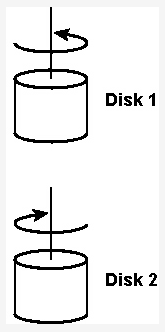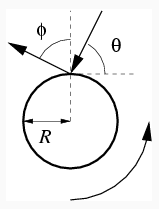Two disks are initially spinning, one above the other on a small axle that provides a small, but non-negligible torque from friction, as shown in the figure below. Both disks have the same radius, R = 2.58 m. Disk 1 has a moment of inertia I1 = 9.8 kg⋅m2. Disk 2 has a moment of inertia I2 = 5 kg⋅ m2. Let vertically up be the z direction, such that counterclockwise rotation as viewed from above corresponds to positive values of the z-component. Disk 1 is initially spinning with a z-component of
The z component of their common angular velcoity is 8.837 rad/s
The thermal energy created by disk one falling on disk 2 is 2145.5 J
You want to speed up the system of rotating disks. To do this, you throw a ball of mass mb at the two disks that are still rotating together with the same speed (just after they collide). You throw the ball at the disks, and the ball follows the following trajectory as viewed from above.
The ball of mass mb approaches the disks at an angle θ with respect to the tangent line to the disk and rebounds at an angle ϕ with respect to the normal. The ball's initial speed is v0, and its final speed is vf. What is the new z-component of the angular velocity of the system of rotating disks (they still rotate together) after the collision with the ball? Use these values for the parameters:
vf = 2.2 m/s
v0 = 14 m/s
θ = 65.7∘
ϕ = 75.2∘
mb = 1.62 kg
R = 2.58 m
I have been getting 9.455 rad/s which is wrong. the method I used to get this was using the conservation of momentum to get:
((I1ω1+I2ω2)-(Rmbv0cosθ-Rmbvfsinϕ))/(I1+I2).
where am I going wrong?
The picture with the two disks is for the first part of the problem. the one with the angles is for the question I am having trouble with.


Trending now
This is a popular solution!
Step by step
Solved in 2 steps with 1 images




